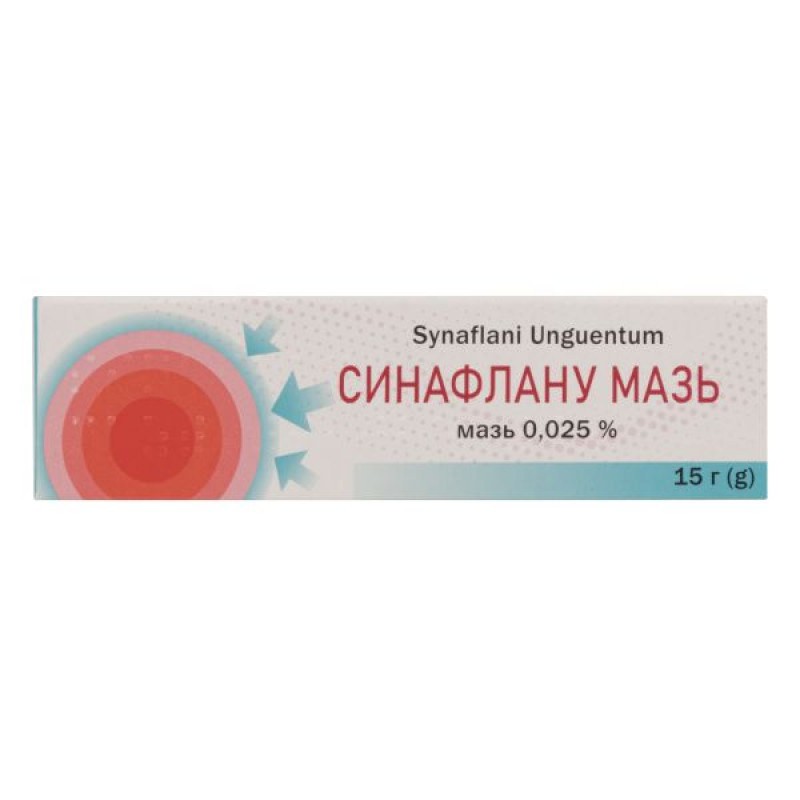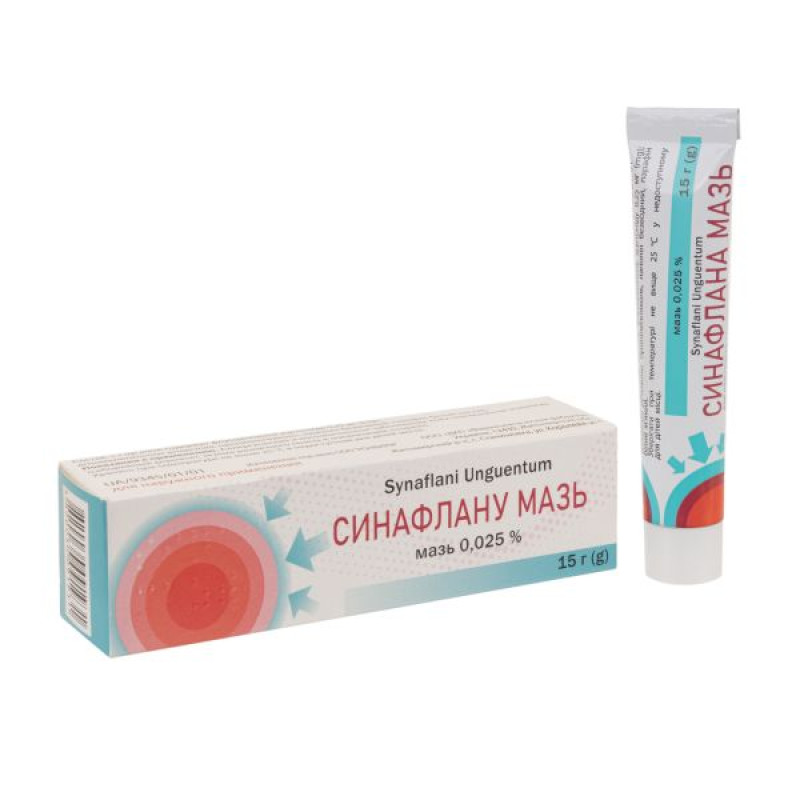Sinaflan ointment 0.025% 15 g

Instructions for Sinaflan ointment 0.025% 15 g
Composition
active ingredient: fluocinolone acetonide;
1 g of ointment contains fluocinolone acetonide 0.25 mg;
excipients: propylene glycol, anhydrous lanolin, white soft paraffin.
Dosage form
Ointment.
Main physicochemical properties: light yellow or yellow ointment with a characteristic odor.
Pharmacotherapeutic group
Corticosteroids for use in dermatology. Simple corticosteroid preparations. Active corticosteroids (group III). Fluocinolone acetonide.
ATX code D07A C04.
Pharmacological properties
Pharmacodynamics.
The active substance is a synthetic fluorinated glucocorticosteroid for external use - fluocinolone acetonide. The drug has anti-inflammatory, antiallergic, antiexudative and antipruritic effects. Reduces the manifestation and eliminates the inflammatory reaction of the skin. Inhibits the accumulation of macrophages, leukocytes at the site of inflammation, inhibits the formation of T- and B-lymphocytes, disrupts their interaction, reduces vascular and tissue permeability, preventing the formation of inflammatory edema. Inhibits phagocytosis, the release of microsomal enzymes and inflammatory mediators.
Pharmacokinetics.
Fluocinolone acetonide easily penetrates the skin through its outer stratum corneum. Absorption of fluocinolone acetonide through the skin is enhanced when applied to sensitive areas of the body and face, as well as to skin with damaged epidermis or inflammatory processes. The use of an occlusive dressing causes an increase in skin temperature and humidity, which also leads to increased absorption of fluocinolone acetonide. In addition, absorption is enhanced with frequent use of the drug and when applied to large areas of skin. Absorption through the skin is higher in adolescents than in adults. The drug is metabolized mainly in the liver. The insignificant absorption of the drug does not have a systemic effect and does not suppress the function of the adrenal cortex. The use of occlusive dressings significantly increases bioavailability, which can lead to the development of general resorptive effects characteristic of fluorinated glucocorticosteroids.
It is excreted in the urine and in small amounts in the bile in the form of glucuronide conjugates in an unchanged state.
Indication
Allergic and inflammatory skin diseases of non-microbial etiology (seborrheic dermatitis, eczema of various genesis and localization, psoriasis).
Contraindication
Hypersensitivity to the active substance or to other glucocorticosteroids and other components of the drug; infectious skin diseases (bacterial, viral, fungal), including skin manifestations of syphilis, skin tuberculosis, pyoderma, chickenpox, herpes, actinomycosis, blastomycosis, sporotrichosis; acne rosacea and acne vulgaris; diaper dermatitis; perioral dermatitis; anogenital itching; skin neoplasms, skin tumors, including nevus, atheroma, melanoma, sarcoma, hemangioma, xanthoma; wounds and ulcerative lesions of the skin, wounds in the application areas, trophic ulcers of the lower leg associated with varicose veins; multiple psoriatic plaques; erosive-ulcerative lesions of the digestive tract. Do not use after prophylactic vaccinations. The drug is not used in ophthalmology.
Interaction with other medicinal products and other types of interactions
The drug may enhance the effect of immunosuppressive drugs and inhibit the effect of immunostimulating, hypotensive, diuretic, antiarrhythmic drugs, and potassium preparations.
The drug can be used with antimicrobial agents of local and systemic action.
Concomitant use with systemic glucocorticosteroids increases the effectiveness of the drug, but at the same time increases the likelihood of side effects.
Concomitant use of the drug with nonsteroidal anti-inflammatory drugs increases the risk of developing systemic and local side effects.
Diuretic drugs (except potassium-sparing ones) increase the likelihood of developing hypokalemia.
The slight absorption of "Sinaflan Ointment" when applied externally does not lead to interactions with other drugs.
During treatment with the drug, it is not recommended to be vaccinated against smallpox, as well as to carry out other types of immunization (especially with prolonged use on large areas of skin) due to the possible lack of an adequate immunological response in the form of the production of appropriate antibodies.
Application features
Treatment must be carried out under the supervision of a doctor.
The drug is used only in short courses (do not use continuously for more than 10 days) on small areas of the skin. With long-term use on large areas of the skin, the frequency of side effects increases and the possibility of developing edema, arterial hypertension, hyperglycemia, and decreased resistance increases.
Use with caution on areas of the body with thin skin (face, groin, inguinal folds), as increased absorption and a high risk of side effects (telangiectasia, perioral dermatitis) are possible even after short-term use.
Do not apply to the skin of the mammary glands.
The ointment should not be used simultaneously with other medicines for external use.
Visual impairment is possible with the use of systemic and topical corticosteroids.
If symptoms such as blurred vision or other visual disturbances occur, an ophthalmologist should be consulted to evaluate possible causes, which may include cataracts, glaucoma, or rare diseases such as central serous chorioretinopathy, which has been reported with the use of systemic and topical corticosteroids.
Avoid getting the drug in the eyes.
If skin irritation occurs at the site of ointment application, the use of the medicinal product should be discontinued.
In case of infection at the site of application of the ointment, appropriate antibacterial or antifungal treatment should be carried out. If the symptoms of infection persist, the use of the drug should be discontinued for the period of treatment of the infection.
When using the drug externally, the following are possible: a decrease in the production of adrenocorticotropic hormone by the pituitary gland due to suppression of the hypothalamic-pituitary-adrenal system, a decrease in the level of cortisol in the blood, and the development of iatrogenic Cushing's syndrome, which disappears after discontinuation of the drug.
Periodic monitoring of adrenal cortex function should be performed by determining cortisol in the blood and urine after adrenal stimulation with adrenocorticotropic hormone during prolonged use.
The drug should be used under special supervision in patients with psoriasis, since topical application of glucocorticosteroids to areas affected by psoriasis may lead to the spread of relapse caused by the development of tolerance, to generalized pustular psoriasis, and systemic toxicity caused by skin dysfunction.
Use the drug with caution in the presence of subcutaneous tissue atrophy, especially in elderly patients.
During treatment, it is not recommended to get vaccinated against smallpox, as well as to undergo other types of immunization.
Since the medicine contains propylene glycol, it may cause skin irritation upon application.
Since the medicinal product contains lanolin, its use may cause a local reaction (e.g. contact dermatitis).
Use during pregnancy or breastfeeding
The drug is contraindicated during pregnancy. Breastfeeding should be discontinued during treatment with the drug.
Ability to influence reaction speed when driving vehicles or other mechanisms
Does not affect.
Method of administration and doses
The drug is intended for topical use only. Apply a small amount of the drug and rub in lightly 1-2 times a day. The duration of treatment is determined by the doctor individually and depends on the nature of the disease, usually 5-10 days, but not longer than 2 weeks.
Children over 2 years of age should be used with caution once a day under the supervision of a physician. The duration of use in children should not exceed 5 days.
The ointment should not be used under an occlusive dressing; only in the case of psoriasis is it permissible to use the drug under a closed dressing, which should be changed every day.
Do not apply to facial skin for longer than 1 day.
The ointment is mainly recommended for use in dry forms of dermatoses.
Children
The drug is used in children over 2 years of age with caution, under the supervision of a doctor, only once a day, on a small area of skin. Do not apply the ointment to the child's face.
Overdose
With prolonged use on large areas of skin, symptoms of overdose may appear, manifested by increased side effects.
Symptoms: edema, arterial hypertension, hyperglycemia, glycosuria, increased sensitivity to infections, and in severe cases - Itsenko-Cushing syndrome; local - itching, burning of the skin at the site of application of the drug.
Treatment: symptomatic against the background of gradual withdrawal of the drug.
Adverse reactions
Skin and subcutaneous tissue disorders: urticaria, allergic contact dermatitis, skin irritation, atrophic streaks, maculopapular rash, skin maceration at the application site, skin integrity disorders, hyperkeratosis, perioral dermatitis, furunculosis. Secondary skin infections and atrophic changes in the skin (burning, itching, dry skin, steroid acne, folliculitis) may develop. With prolonged use, skin atrophy, local hirsutism, telangiectasias, exacerbation of eczema, purpura, pigmentation disorders, hypertrichosis, alopecia, especially in women, are possible.
Visual disturbances: blurred vision; cataracts or glaucoma may occur.
Endocrine system disorders: hyperglycemia. When applied to large areas of skin, systemic manifestations are possible: adrenal insufficiency, growth and development inhibition in children, Itsenko-Cushing syndrome, steroid diabetes mellitus.
Immune system disorders: decreased body resistance. With prolonged use, secondary immunodeficiency (exacerbation of chronic infectious diseases, generalization of the infectious process, development of opportunistic infections), slowing down of reparative processes are possible.
Cardiovascular system disorders: arterial hypertension, possible development of edema.
Expiration date
5 years.
Storage conditions
Store at a temperature not exceeding 25 °C in a place inaccessible to children.
Packaging
10 g or 15 g in a tube; 1 tube in a pack.
Vacation category
According to the recipe.
Producer
LLC "SKP "Pharmaceutical Factory".
Location of the manufacturer and address of its place of business
Ukraine, 12430, Zhytomyr region, Zhytomyr district, Stanyshivka village, Koroleva st., bldg. 4.
There are no reviews for this product.
There are no reviews for this product, be the first to leave your review.
No questions about this product, be the first and ask your question.





